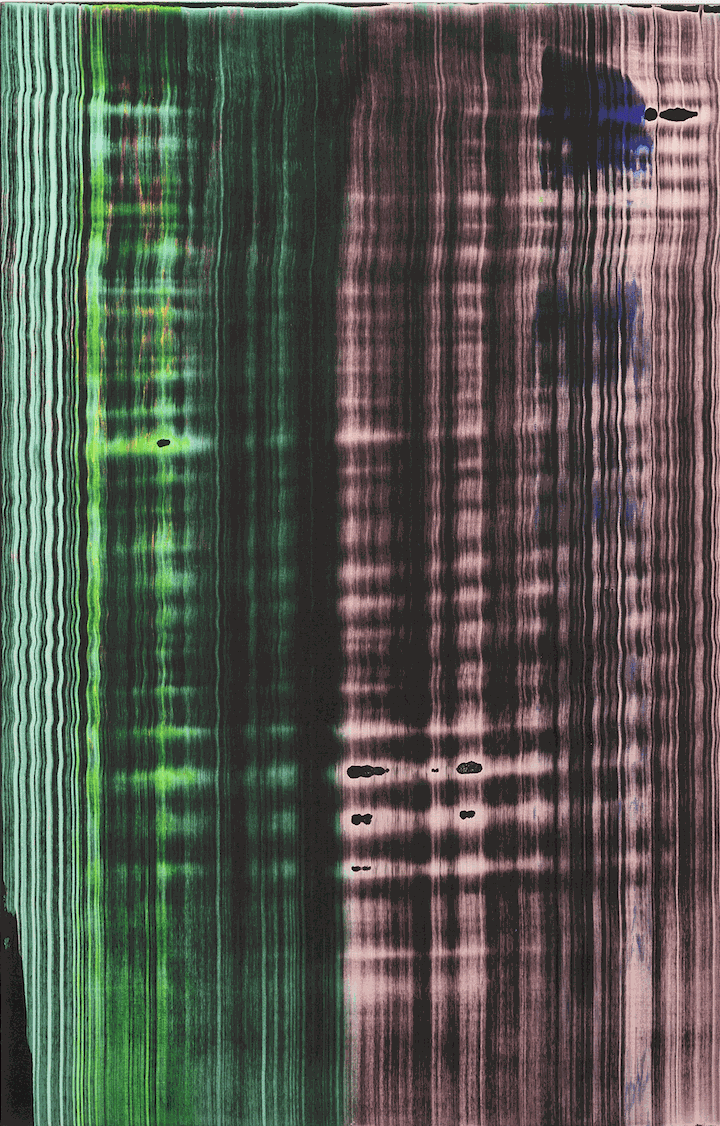-
-
JD Malat Gallery is pleased to announce its participation in EXPO Chicago 2025. We will be presenting an extraordinary dialogue between abstract works by father and son, Ed Moses (1926 – 2018) and Andy Moses (b.1962). This carefully curated presentation explores the profound artistic legacy and evolution of abstraction across generations, showcasing the elder Moses's groundbreaking experimental techniques alongside his son's innovative approach to colour and form. The exhibition highlights both the distinctive qualities of each artist's practice and their shared commitment to pushing the boundaries of abstract painting, creating a compelling narrative about artistic inheritance and individual innovation within the contemporary art landscape.
-

-

-
Ed Moses, Who Cross, 2008

Who Cross exemplifies Moses’ process-driven practice. Using tools such as rods coated in paint, which he would drag or lift from the canvas, he created patterns that resemble waves or fields of interference. The result is a surface marked by the trace of action, part control, part chance. This piece captures Moses’ enduring interest in repetition, gesture and the physical act of painting as a form of enquiry.
-
Andy Moses, Geodesy 1234, 2022

Geodesy 1234 explores forces of motion and geometry through swirling, centrifugal patterns. The circular format enhances the sensation of movement, drawing the viewer into a vortex of blue and cream. Moses works with gravity and viscosity, allowing paint to shift naturally across the surface. The result is both controlled and organic. Free of hard edges or fixed centres, the painting feels boundless, like a current spinning endlessly outward, or the slow pull of tides beneath a mirrored surface.
-
Ed Moses, Ad-8, 2007

Ad-8 was created during what is often considered Moses’ mature period, a phase marked by refined control over his process and a deepened exploration of gesture, surface and spontaneity. By the 2000s, Moses had already moved beyond the hard-edged abstraction of his earlier career, embracing a more fluid and intuitive approach. In this work, sweeping brushstrokes loop and intersect across a luminous surface, each movement revealing layers of colour beneath. Moses was never interested in fixed outcomes; instead, he allowed the process itself to guide the painting, resulting in compositions that feel alive with rhythm and immediacy. Ad-8 exemplifies this evolved practice, inviting the viewer to follow the choreography of the brush and the play between control and chance.
-
Andy Moses, Geomorphology 1108, 2025
 Geomorphology 1108 continues Moses’ exploration of natural forces through abstraction. Painted in radiant gold, the piece recalls sunsets, dunes and shifting landscapes. The monochrome palette invites a meditative response, while the concave panel adds dimensionality. His use of paint mimics the movement of water, wind or lava, turning the canvas into a liquid terrain. Like many of Moses’ works, it offers a reflection on nature’s vastness and our place within it.
Geomorphology 1108 continues Moses’ exploration of natural forces through abstraction. Painted in radiant gold, the piece recalls sunsets, dunes and shifting landscapes. The monochrome palette invites a meditative response, while the concave panel adds dimensionality. His use of paint mimics the movement of water, wind or lava, turning the canvas into a liquid terrain. Like many of Moses’ works, it offers a reflection on nature’s vastness and our place within it. -
Andy Moses, Geomorphology 1428, 2023

In Geomorphology 1510, Moses creates wave-like patterns that flow across a curved panel. His technique of pouring and guiding paint with gravity produces fluid, layered compositions reminiscent of tides, wind and geological strata. The concave surface enhances this sense of motion, with light catching different angles as viewers move around it. The work evokes the sea, the sky and natural formations, echoing the artist’s deep connection to the Californian landscape and his lifelong practice of surfing.
-
Ed Moses, El Azule, 2006

In El Azule, Moses delves into colour as both form and feeling, building a dense field of blue gestures that oscillate between depth and surface. The title nods to the Spanish word for blue, suggesting a focus on tonal exploration as well as an engagement with cultural or linguistic resonance. Moses was deeply interested in the mutability of perception, often working with repetition and layering to create works that shift as the viewer moves. Here, the gestural application of paint evokes movement and atmosphere, yet remains grounded in formal structure. The painting demonstrates his ability to balance expressive freedom with compositional intent, resulting in a work that feels immersive, deliberate and open to interpretation.
-
Ed Moses, Gold Bach, 2002

In Gold Bach, Moses explores material and surface through luminous purples and matte blacks, applied in thick, cracked forms. Metallic pigments and specks of glitter catch the light, hinting at geological formations or cosmic textures. The work speaks to Moses’ continual experimentation with materials, squeegees, squirt bottles, and various layering techniques, resulting in a composition that is both sensuous and formally rigorous.
EXPO Chicago : Booth 249
Past viewing_room









